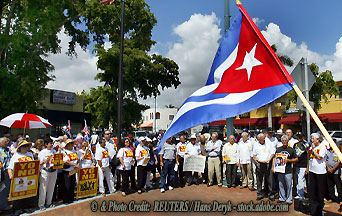
On the sixtieth anniversary of the Bay of Pigs Invasion in Cuba, many people are aware of this tragic event. The author and Catholic Cuban activist Sergio de Paz collected stories from survivors of this veritable crusade. However, before telling their stories, we will provide the historical context of the times.
In the early sixties, when the world was still recovering from the wounds of two world wars, a strong wind of optimism began to blow everywhere. People ignored the “prophets of doom” that warned about post-war dangers. All prepared instead to enter a fresh new world.
In the Eternal City, Pope John XXIII promised to blow off the dust of tradition, which he thought had accumulated in the Church by opening up the windows to let in the fresh air of change.
In the United States, the young and smiling President John Kennedy was elected. In Russia, the era of mustached communism strongmen seemed over. The new leader reached out and spoke of dialogue with the West.
Communism and Anticommunism on the Threshold of the Millennium’s Last Decade
The Catholic world awaited with great expectation for news of the third part of the secret of Fatima, which Sister Lucy asked to be revealed in 1960. It is said that the Pope opened the envelope with the secret, read it, resealed it. He said: “This is not for our days.” How logical this was since the prophecy of the Virgin of Fatima seemed to go against the prevailing optimistic climate.
Meanwhile, a Jesuit-educated dictator took power in Cuba. He soon revealed his goals. Fidel Castro implanted a communist regime that served as a hydra with tentacles extending to the Americas. Soon there were reactions against communism that took on the character of a religious crusade to save Latin America from the Red foe.
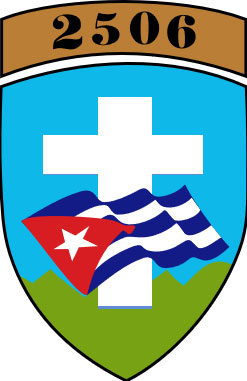
Photo Credit: MrPenguin20 CC BY-SA 4.0
Exiled Cubans
In early 1961, a movement to free Cuba was born. It was called Assault Brigade 2506. Its symbol was the Cuban flag with the cross in the background.
A stanza from the anthem of the brigadistas stated:
Nothing stops you
this war is ours
If it’s a holy war,
let’s go with the cross.
At the April 16 commemoration of the frustrated attack on the Bay of Pigs, we went to a tribute to the heroes of this crusade held at the monument dedicated to them in Miami. Local authorities, surviving brigade members and relatives of brigade members were present.
Sérgio de Paz is a native Cuban and director of the Cubanos Desterrados movement. He interviewed many at the event. A large number of expatriates live in Miami, where they suffer the pain of being severed from the land of their birth. They left everything to live in a strange land that received them well. However, nothing can make up for a homeland left behind. Indeed, the symbol of Cubanos Desterrados is an image of the Cuba’s most beloved image of Our Lady, the Virgen de la Caridad del Cobre.
Invasion of the Bay of Pigs
We asked those present what happened at the frustrated attack on the Bay of Pigs. One veteran explained that the Bay of Pigs does not refer to the animal but to a local “pigfish,” which is abundant in the bay. The literal translation is unfortunate.
The Bay of Pigs Invasion was a failed attempt to invade Cuba’s southwest coast. It was carried out in April 1961 by anti-Castro Cuban exiles organized as Brigade 2506. The group had been trained and directed by the CIA, with support from the American Armed Forces. The objective was to overthrow the Castro government.
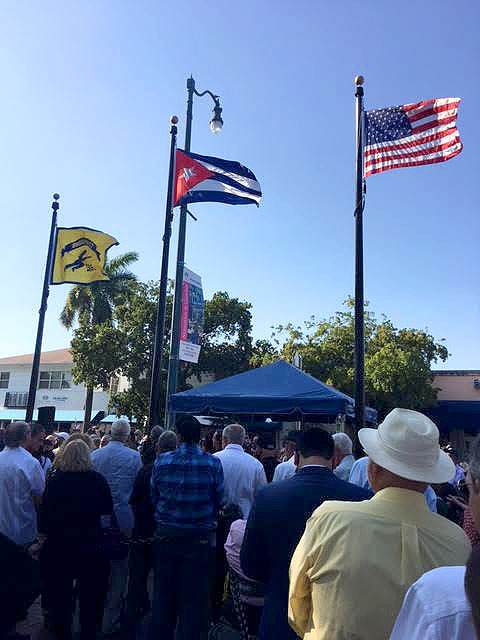
One Brigade member told us: “If someone had devised a plan destined for failure, the one we followed was it.” In his book Sedientos de Libertad, author Lázaro Abreu says: “The 2506 Brigade was composed of 1,500 brigade members, who faced a contingent of 90,000 militiamen, soldiers and police officers.”
The writer tells how about 200 members gave their lives in the swamps of La Ciénaga de Zapata. Many others died at La Rastra de la Muerte when they were blocked and massacred on the way to Havana. Raul Castro authorized Captain Osmani Cienfuegos to carry out a brutal massacre. He boasted that “We are saving the Revolution the cost of a handful of bullets.”
A Specter is Haunting America — Socialism
As the 2506 Brigade surrendered, some fighters entered the depths of La Ciénaga de Zapata swamp, trying to escape the militia’s pursuit. They hid for several days in isolated places, walking at night through mangroves, swamps and coastal reefs without fresh water. On the verge of dehydration, they discovered a small rowboat in a lonely cove near the Guanacabibe Peninsula. They waited for night to approach and launched themselves into the sea. The raging Gulf of Mexico foiled their daring escape. Their names and exploits are recorded in the memory of those who survived.
Due to political pressure and protests, President Kennedy negotiated with Havana to obtain the release of the brigade members. The prisoners were exchanged for medicine and food for Cuban children. These items, however, were diverted to the Soviet Union, and the Cuban people received less than 10% of the total received.
Combatants Without the Promised Support
We spoke with Colonel Johnny López de La Cruz, Brigade member and President of the Brigade Museum. He confided to us:
“The Brigade was founded and made up of young people who wanted freedom for Cuba. They had very deep Catholic roots. Unfortunately, we were unable to fulfill our goal, but we feel very proud of what we did, and the struggle has continued for these 60 years.
“It all started in the sixties when the Cuban people realized that the Castro regime was not good for the nation. People became discontent and sought to fight against the Castro government. All kinds of people joined the movement – peasants, doctors, engineers, etc. They all wanted to fight communism.”
“The cause of the failure is complex. One thing that ruined the operation was when Kennedy reduced the promised support to the troops.
“They canceled flights to attack Cuba, but we needed control of the air to conduct the fight. Logistical support also did not exist. We learned this when it was too late.
“We struggled until we ran out of ammunition, which lasted three days. It was a betrayal, which caused frustration in our ranks. Many rosaries displayed here in the museum were made in prison, with soft wood from cigar boxes, using spoons turned into tools.”
Some 104 Cubans were killed in combat, in addition to four American pilots who flew on the third day without knowing exactly what was happening.
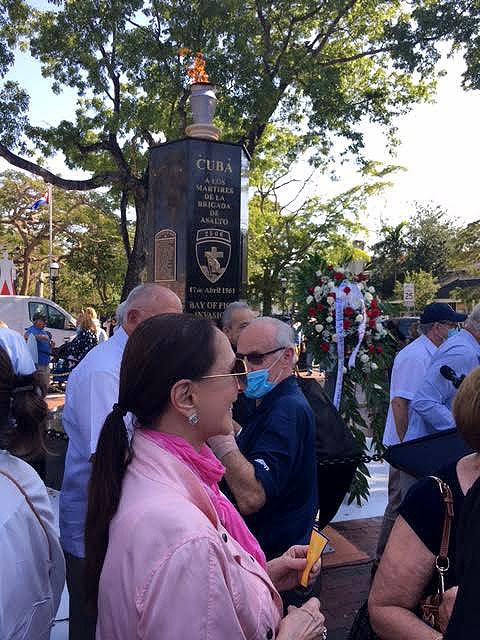
Change of Government Hurting Plans
Myrna is the widow of Pepe Millán. She received us at her home in Miami Beach and gave us this report, which we completed with facts from a Brigade member. Her husband heroically died in the hands of the enemy. He was one of many prisoners crowded into a closed truck, where the heat was unbearable. They remained in the suffocating space for seven hours on their way to Havana. After a short time, a mixture of sweat and other fetid liquids formed on the floor, which moved from one side to the other according to the vehicle’s movements. They had the idea of opening two holes in a rusty part of the body to gain access to the outside air. Each man took his turns breathing the fresh air. Pepe was among the most robust men who needed a greater volume of oxygen. However, he gave his turn to another, which cost him his life.
Mrs. Millán summarized her husband’s story:
“My husband came from Cuba, started working and studied law here. He then got involved in organizing efforts to gain the freedom of our country. We lived in exile, with part of the family still in Cuba.
“I didn’t want him to get involved because it was dangerous. He told me that it was organized by the Americans, who had never lost a war. He believed in this guarantee. He said that ‘We will fight, we will disembark, but they train us.’
“The training camps were in Guatemala. We only communicated by letter and discreetly, so no one would know where he was. We followed him with prayers for the success of the operation. Finally, they landed at Playa Girón in Cuba.
Eternal and Natural Law: The Foundation of Morals and Law
“The government had just changed in the United States. It appears that Kennedy disagreed with or was not fully aware of what they were going to do. Thus, we did not get the promised help. The Cubans fought, but the logistical support and training were in the hands of the Americans. On the beach, the help did not arrive. They fought for three days until the ammunition ran out. Airplanes were refueled in Nicaragua, wasting precious time. All this was very sad.
“My husband was taken prisoner and put into a truck without air, where he died.
“Amid these horrors, I was consoled to know that he comforted others not to despair. They knocked on the walls to get attention. And the communists said: Let’s not shoot them. If they die here, we save ammo. There were more than a hundred in the truck, ten of which died there.”
Mrs. Millán said that before he died, her husband said: Look at the Cross. The Virgin of Charity is taking me now. It is said that he saw a luminous cross before him before expiring. He held the rosary so tightly that it was impossible to remove it after death.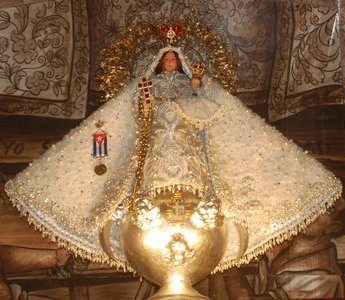
May the blood of these martyrs and the good seed scattered a hundred years earlier by the great missionary Saint Anthony Marie Claret, Archbishop of Santiago, still bear much fruit. We pray that Cuba, the ancient Pearl of the Antilles, may be counted among the nations that will make up the Reign of the Immaculate Heart of Mary, promised at Fatima.
Photo Credit (Top): © REUTERS / Hans Deryk – stock.adobe.com

